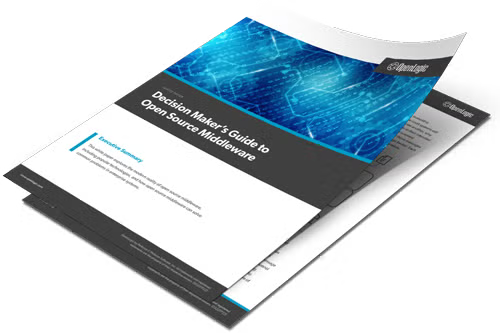Blog
November 29, 2023
Apache Kafka vs. Redis isn't the 1:1 comparison a lot of people seem to think it is. In this blog, we clear up some of that confusion with a comparison of Kafka vs. Redis, and an explanation of the unique problems they can solve.
Overview of Apache Kafka and Redis
Kafka is an open source stream-processing platform, while Redis is a general purpose in-memory data store, so they serve very different functions within application data infrastructure.
What Is Apache Kafka?
Apache Kafka is an open-source stream-processing platform designed for high throughout, low latency processing.
Whereas traditional message brokers focus on a pattern of allowing consumer applications to work on one piece of data at a time, Kafka allows for the analysis of lots of individual pieces of inflight data.
This makes Kafka an ideal candidate for implementing streaming analytics and big data applications. Designed at LinkedIn to scale to hundreds of millions of messages, though not as lightweight a solution as ActiveMQ, it is ideal for working on astronomically large data sets.
What Is Redis?
Redis (Remote Dictionary Server) is a general purpose, in-memory data store that supports a variety of data types, including strings, hashes, lists, sets, and stores sets.
Redis was one of the first open source key caching solutions, which has led to its widespread adoption as a database cache. While Redis is primarily used for highly-available in-memory caching, it can also be used for chat, messaging, queues, session stores, and rich media streaming.
Back to topLooking for a More Relevant Kafka Comparison?
In our Decision Maker's Guide to Open Source Middleware, our experts discuss the top options available today, including Kafka, ActiveMQ, RabbitMQ, and more!
Kafka vs. Redis: Features Comparison
| Feature | Redis | Kafka |
| Data Persistence | None | Persistent, with options for data retention |
| Message Delivery | At-most-once | At-least-once, exactly-once support possible via Transactional API |
| Message Ordering | Limited (within a single channel) | Guaranteed within a partition |
| Scalability | Horizontal scaling via sharding/Redis cluster | Horizontal scaling via partitioning |
| Message Retention | No native persistence | Configurable retention period |
| Message Acknowledgment | No explicit acknowledgment mechanism | Acknowledgment mechanism for consumers |
| Pub/Sub Support | Native support within channels | Native support with topics and partitions |
| Distributed System | Distributed, sharding/Redis cluster | Distributed, ZooKeeper/KRaft |
| Use Cases | Caching, real-time analytics, leaderboards | Event streaming, log aggregation, analytics |
| Complexity | Simpler, lightweight | More complex, designed for event streaming |
A head-to-head features comparison, as shown in the table above, further underlines how the different problems Redis and Kafka were designed to solve is reflected in their differing capabilities and attributes.
Redis is often used when low latency and simplicity are crucial, such as in caching scenarios or real-time analytics. Redis does not inherently provide the same level of durability or fault tolerance as Kafka, and its use as a message broker may be more suitable for scenarios where these features are less critical. And while Redis itself doesn't support it, Redis Streams does provide support persistence and can support at-least-once delivery semantics.
Kafka is designed for event streaming scenarios where durability, fault tolerance, and scalable message processing are key requirements, such as in log aggregation and building data pipelines. Kafka's partitioning and distributed nature make it well-suited for handling large volumes of data and supporting high through-put, fault-tolerant architectures. And Kafka Connect provides a robust plug-and-play client framework that supports numerous "sync" types.
Back to topApache Kafka vs. Redis Use Cases
When teams think about Kafka vs. Redis in terms of use cases, they need to think about them as serving completely different purposes within their data infrastructure. In some cases, Kafka and Redis can even be used as complimentary pieces within that infrastructure (e.g. Kafka and Redis can be deployed together for real-time analytics use cases).
When to Use Kafka
Kafka has a number of potential use cases that span across many verticals, including Internet of things (IoT), e-commerce, security, and financial institutions — all of which can benefit from real-time data analysis. For those who only need to process a small amount of messages (up to several thousand), Kafka might be overkill.
It is also important to note that Kafka, while powerful, is also complex. It’s not easy to perform data transformations that involve a complex pipeline of producers and consumers. If your needs require Kafka, then you have a substantial amount of work ahead of you!
When to Use Redis
Redis is highly scalable, and can scale well in most deployment architectures. Because it provides sharding and multiple types of replication, Redis offers a highly flexible and reliable option for teams who need an in-memory data store.
Historically, Redis has primarily been used as a enterprise-grade session cache, but more recently Redis has found a home in a variety of new use cases -- like inventory systems or fraud analysis. Because Redis was designed as a general purpose key storage, there are some areas where it can be outshined by alternatives (e.g. ElasticSearch for more search-focused datastores).
For teams considering Redis as a pub/sub message broker, it's important to note that it should not be considered a fully-functional message broker service due to it's lack of support for exactly-once delivery semantics.
Back to topFinal Thoughts
Finding the right open source software for your use case can be hard. That's especially true when you consider the sheer amount of open source projects available for use today. This tyranny of choice can be further complicated by the advertised features for projects that often don't match their ideal use cases.
At the end of the day, it's up to teams to perform their due diligence when selecting new pieces of open source software to ensure that the functionalities in that software are the ones best equipped to solve their specific use cases. For teams that don't have that expertise in-house, there are companies, like OpenLogic, that can provide guidance and support.
Need Help With Your Open Source?
OpenLogic can help. We provide the expert technical support and guidance teams need when using open source in mission-critical applications. Learn more about how we can help by talking with an expert today.
Additional Resources
- Guide - Intro to Open Source Databases
- White Paper - Decision Maker's Guide to Open Source Databases
- Solutions - Kafka Service Bundle, LTS, and Technical Support
- Blog - Exploring Redis Alternatives
- Blog - Overview of Open Source Key-Value Databases
- Blog - Kafka vs. RabbitMQ
- Blog - How to Develop a Winning Kafka Partition Strategy
- Blog - Should You Be Paying for Middleware Tools?
- Blog - Using Kafka With ZooKeeper

